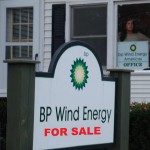
Oil giant responsible for 2010 Gulf blowout retrenches in fossil fuels.
by Stephen Leahy
BP’s decision comes as the renewable sector reaches new heights. Renewable energy sources — water, wind, solar, biomass — account for nearly 15 percent of US electrical generation. Only one new coal power plant has been built in recent years and another 150 planned coal plants have been cancelled.
Nuclear power is increasingly considered too risky and too expensive. While natural gas-fired power plants are booming thanks to low-cost gas. In the US, renewables accounted for 82 percent of new electrical generating capacity in the first three months of 2013.
In 2012, wind added nearly half of all new US electrical generation. Renewables also have support from US president Barack Obama who said in his February State of the Union address: "As long as countries like China keep going all-in on clean energy, so must we."
BP can make more money faster sticking to oil and gas, says Edward Hirs, an energy economist at the University of Houston. “It’s a strategic decision. Renewables are not their core business.”
So why is BP plc, one of the world's energy giants, selling its considerable US wind energy assets?
BP can make more money faster sticking to oil and gas, says Edward Hirs, an energy economist at the University of Houston. "It's a strategic decision. Renewables are not their core business," Hirs told this reporter.
And there is the fact that BP needs lots of cash, since they face more than US$42 billion in costs and fines for the 2010 Deepwater Horizon accident that killed 11 people and triggered the worst offshore oil spill in US history. Another 160,000 claims for damages have been submitted under the Deepwater Horizon Economic and Property Damages Settlement.
"There's no limit on how high the final settlement might go…it could be US$100 billion," Hirs says.
BP is one of the world's leading international oil and gas companies. It operates in more than 80 countries and claimed US$375 billion in revenues in 2012.
BP's US Wind Energy division has 16 wind farms, with generating capacity of approximately 2,600 megawatts of renewable power. It also has projects in various stages of development including some 2,000 megawatts of projects that are nearly shovel ready. Industry experts estimate the wind division is worth US$3-4 billion.
The sale is part of a "continuing effort to become a more focused oil and gas company and re-position the company for sustainable growth into the future," a BP spokesperson told this reporter.
The US is on the edge of a complete transformation of its energy system to renewables and will not build another coal or nuclear power plant according to Gipe.
BP says the company remains committed to alternative energy in the form of ethanol production facilities in Brazil and the UK. It continues to invest in "industry-leading research into new biofuel technologies in both the US and the UK."
This is a long way from BP's heady days in 2000 when the world's second largest petroleum company declared it was reinventing itself to go "beyond petroleum." It launched an award-winning US$200 million public relations campaign and invested about US$7 billion in renewables. BP quickly became a large solar energy company by buying other solar companies. However, since the company continued to invest heavily in expanding its oil and gas assets, environmental groups accused it of "greenwashing."
"I'm surprised BP made the move to sell the wind division. It was quite successful," says Paul Gipe, a wind energy expert from California. "However it's not a significant development. Someone will buy its wind farms."
More than 13,000 megawatts of wind energy was installed in the US in 2012, beating the record of 10,000 megawatts in 2009. Much of that activity in 2012 was due to expiry of a tax credit. However that credit has been extended through 2013.
"Wind continues to be a great investment for BP and for America," says Ellen Carey, spokeswoman for the American Wind Energy Association, the leading US industry association.
"These turbines are still operating and will for many years to come, producing clean, affordable, homegrown wind energy."
"When you look at the big investors in wind, it's not fossil fuel companies like BP, it's electrical utilities," Gipe says.
NextEra Energy Resources — owned by utility Florida Power and Light — is the biggest wind company in North America with more than 10,000 megawatts of energy, enough to power 2.6 million homes. Another US utility Duke Energy, along with French electricity giant EDF and Germany's E.ON, are major investors in wind.
The US is on the edge of a complete transformation of its energy system to renewables and will not build another coal or nuclear power plant according to Gipe.
“The key is to get the right combination of electricity sources and storage — which we did by an exhaustive search — and to calculate costs correctly,” says co-author Willett Kempton.
© Copyright 2013 Stephen Leahy, All rights Reserved. Written For: StraightGoods.ca
 Stephen Leahy is an environmental journalist based in Uxbridge, Ontario.
Stephen Leahy is an environmental journalist based in Uxbridge, Ontario.
Sorry, the comment form is closed at this time.